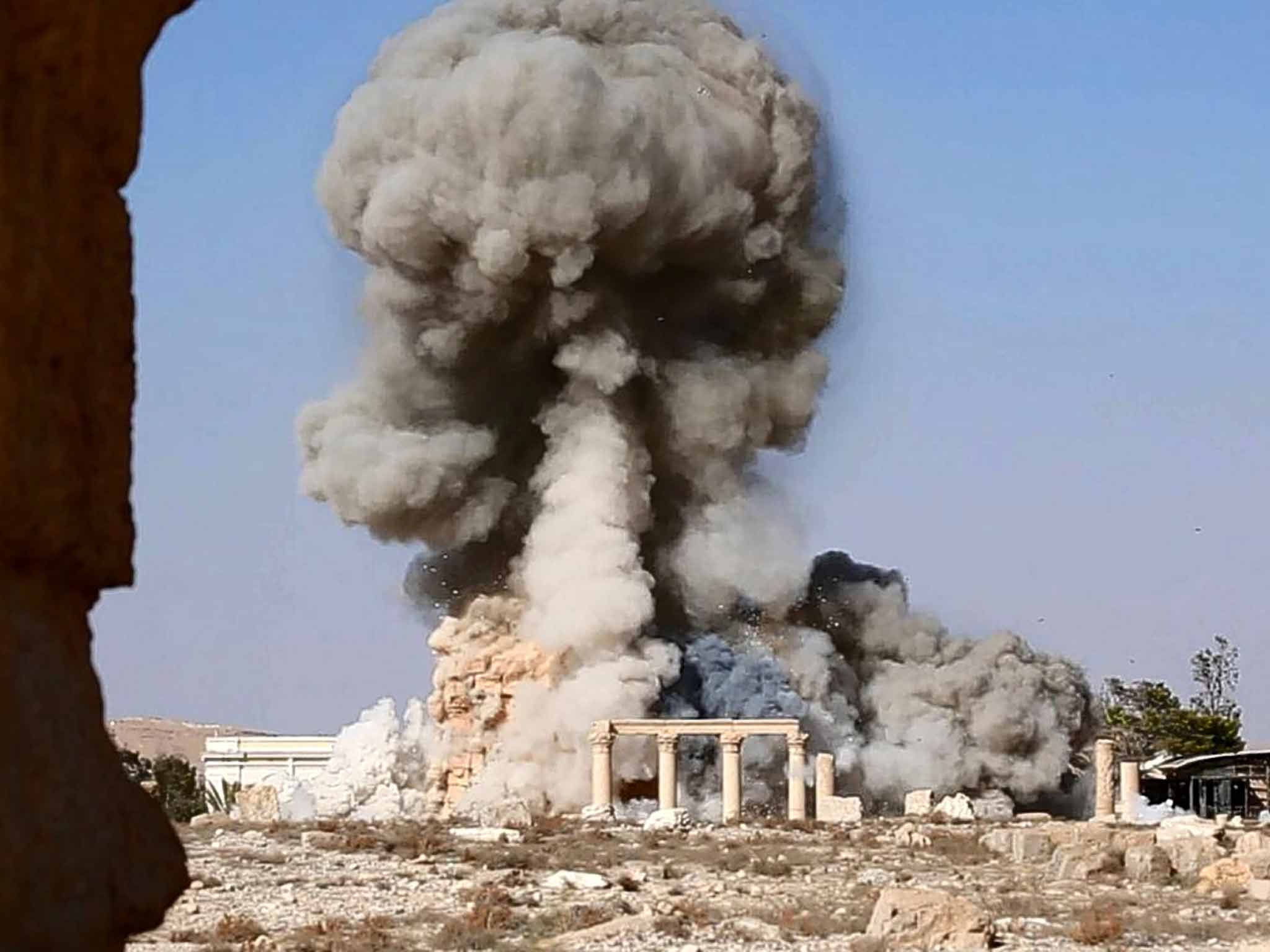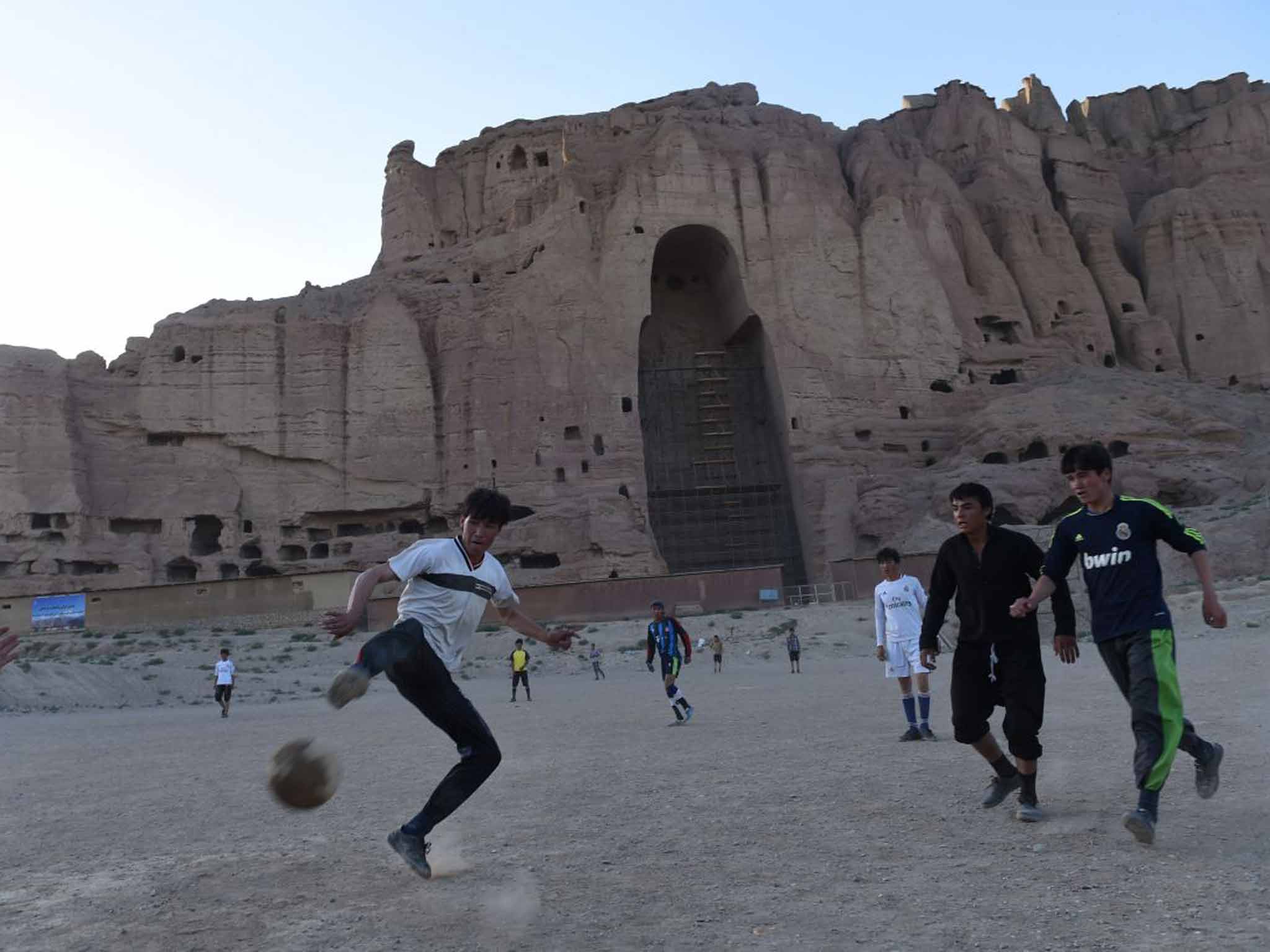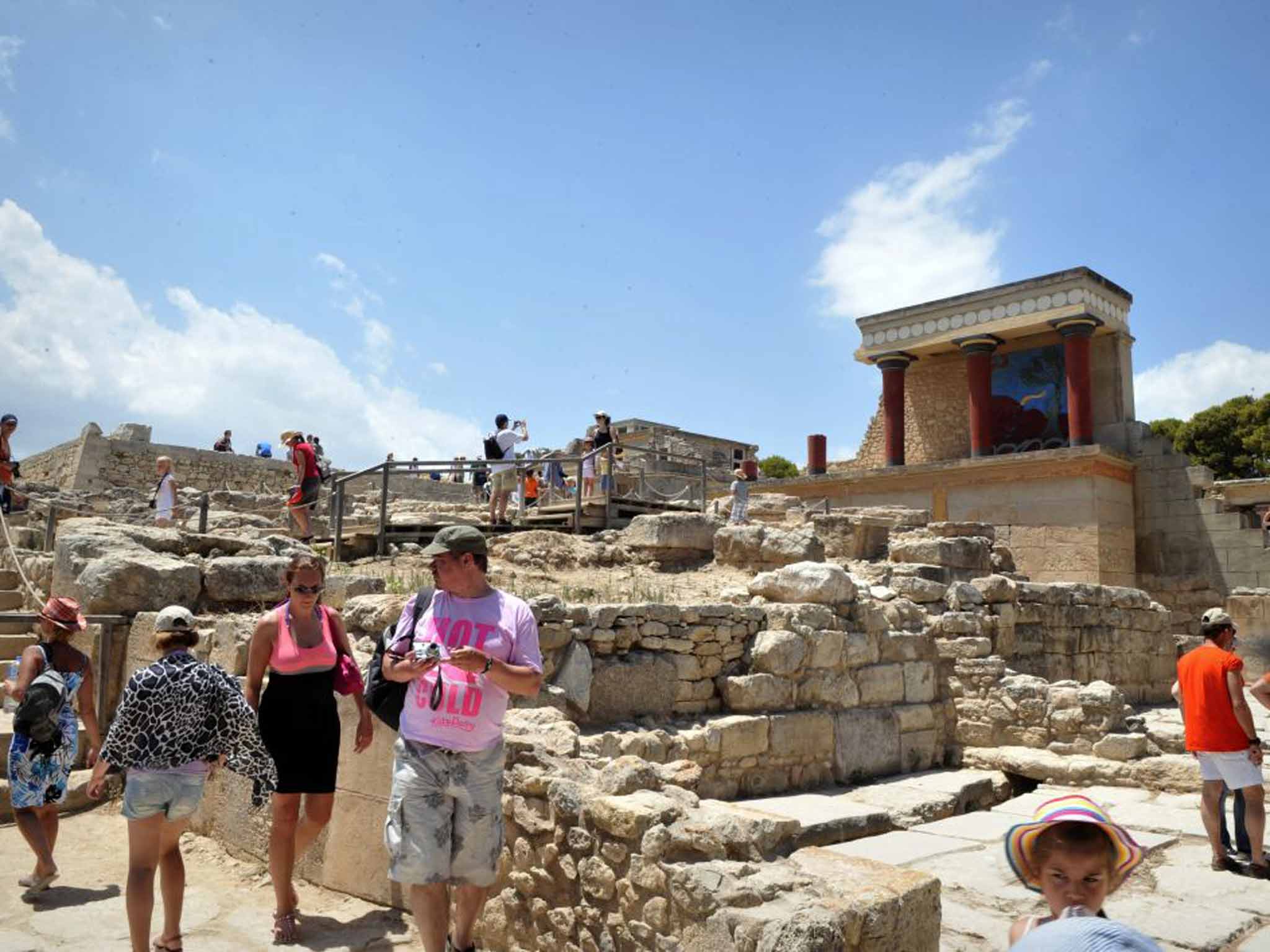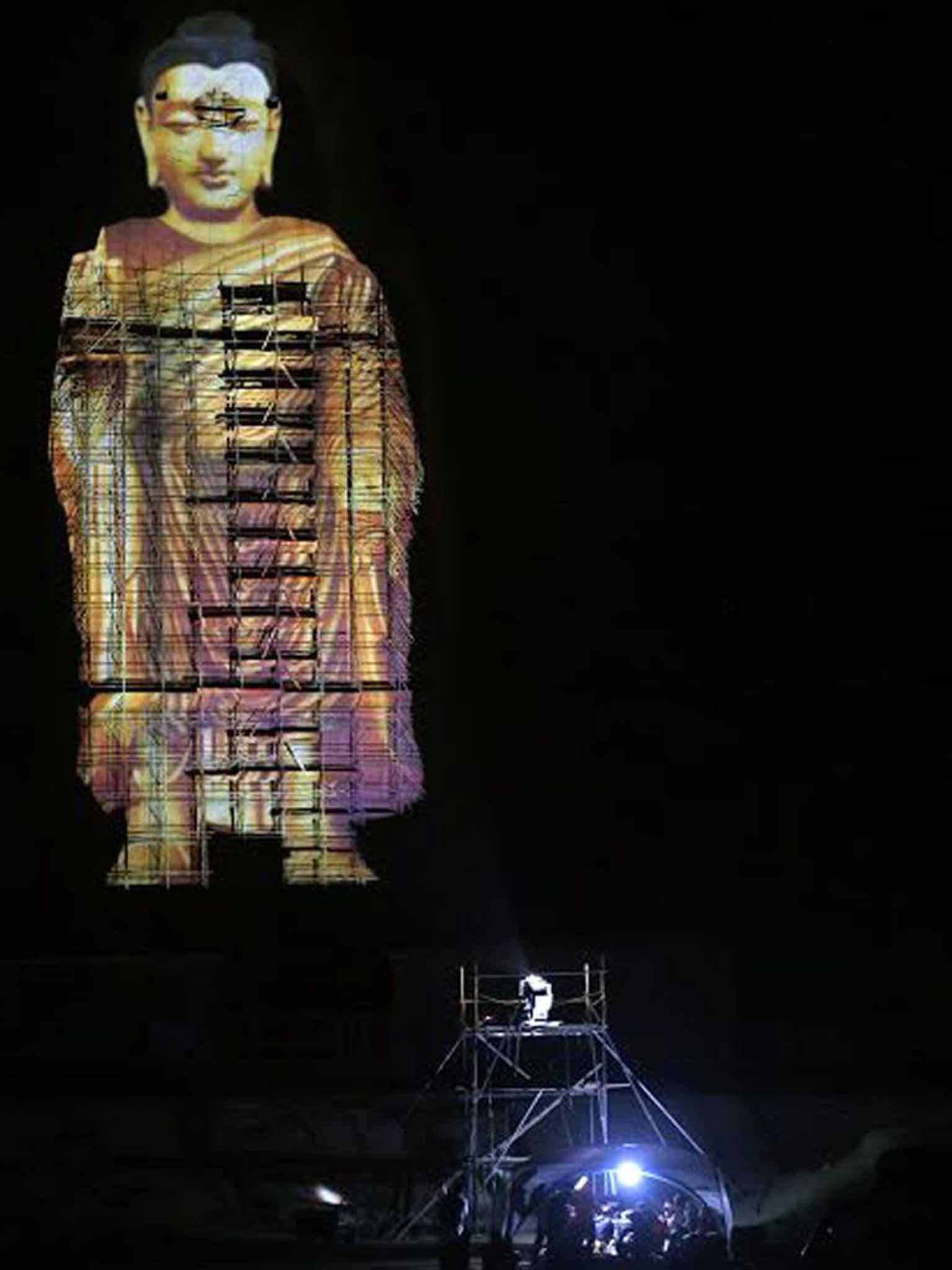The lives and deaths of buildings: Should we try to preserve ruins?
The demolition of Palmyra's ruins is nothing new. By accident or design, great buildings and monuments have always been toppled. And as James Crawford says in his new book, the question has always been what to do in the aftermath

In June this year, at sunset in a high-altitude valley in Afghanistan overlooked by the mountains of the Hindu Kush, a pair of Chinese documentary-makers staged a remarkable event. To the accompaniment of music, and watched by a crowd of 150 local people, they raised a 55-metre-tall statue into a massive alcove carved out of a sheer sandstone cliff face. The statue depicted the ancient Afghan Prince Silsal in the traditional form of a Buddha. Directly alongside was another alcove, created originally to house a second, 38-metre-tall Buddha – Silsal's love, the Princess Shahnama. For some 1,500 years this pair stood together "side by side, their faces blurred", symbols of "faithfulness in effigy" – to borrow Philip Larkin's famous lines on another couple preserved in stone, the Earl of Arundel and his wife, entombed in Chichester Cathedral.
In March 2001, the Taliban detonated scores of anti-tank mines that they had packed into holes drilled in the stonework of the heads and feet. The statues were blown to smithereens. The loss of Silsal and Shahnama, better known as the Buddhas of Bamiyan, was mourned around the world – a story of wanton cultural desecration. Six months later, of course, two more structures – not lovers, but twins – were brought crashing to the ground. An estimated audience of two billion watched the collapse of the towers of New York's World Trade Centre. It was a world-changing, history-changing event, the catalyst for the "War on Terror"; the entry into Iraq by George Bush and Tony Blair; and the emergence of radical fundamentalism as the dominant issue of the new millennium. The lives – or the deaths – of buildings in the 21st century are a symptom and a cause of global politics.
The resurrection at Bamiyan this summer was fleeting, a temporary mirage: quite literally a trick of the light. Zhang Xinyu and Liang Hong, the husband-and-wife team behind the event, used a specially designed £77,500 laser projector to create a life-size, 3D hologram of Silsal. For two nights the prince stood in his alcove, before the equipment was packed away, and he was gone again. There was no place for Shahnama, however; her space remained empty. Now that the projector has been switched off, the lovers are reunited again, if only in absence.
Debate continues over what to do at Bamiyan, with the Afghan authorities, local people and Unesco split by seemingly intractable disagreement. This, of course, is nothing new. Aristotle's concept of the tabula rasa – the "blank slate" – has found particular resonance in the sphere of architecture. Countless buildings and cities have been destroyed over the course of history, whether by cataclysmic accident or belligerent design. The question has always been – what to do in the aftermath? We build to remember. We also build to forget. Should a structure be recreated just as it was, a replica rising from the rubble or ashes? Should something new emerge? Something that honours its predecessor in its grandness or ambition, or that so far overshadows it that it slips from memory? Should we perhaps preserve a ruin exactly as it has fallen, leave the rubble as a symbol of human frailty and as a lesson to future generations of the artistic and cultural cost of war and intolerance?
Bamiyan continues to pose this question – and now, so too, does Syria. Last week, the UK Culture Secretary John Whittingdale announced a £3m scheme to protect cultural sites from destruction by Isis. To be run by the British Museum over five years, the project's aim is to train local experts in "rescue archaeology", giving them the skills to assess, survey and stabilise ancient sites to begin the process of conservation, preservation and perhaps even reconstruction. "We cannot stand by and ignore this appalling, deliberate attempt to erase the rich cultural heritage and sense of belonging for all communities in Iraq and Syria," Whittingdale said. Neither is the work to be confined to the Middle East. Its stated ambition is to develop a "Cultural Protection Fund" to "rescue ancient sites and objects from destruction by terrorists, wars or natural disasters across the world". It is a noble cause and an important recognition of the global scale of architectural and artefact destruction today, although one might question how much £3m can achieve. And clearly it is in no small part prompted by what has happened to the most high profile of threatened Syrian sites, Palmyra.

For months, Isis has been eroding systematically the "heretical" stonework of this ancient city, in one of the most concerted pieces of public "iconoclasm" that the modern world has seen. Propaganda videos show structures and artefacts being smashed by chisels, hammers, pneumatic drills, bullets and high explosives. But this is only half the story. As it advances through Iraq, Isis is simultaneously gathering artefacts and selling them to the highest black market bidders. A new term has emerged to describe this trade – "blood antiquities". Such is the sad fate of the cradle of civilisation: blown up or sold off. Everything must go.
Some believe new technology offers a solution to stem the tide of destruction. In March, the EU-funded Initial Training Network for Digital Cultural Heritage (ITN-DCH) launched "Project Mosul", a scheme to recreate the artefacts lost or destroyed when Isis ransacked the museum in the Iraqi city of Mosul. The simple concept is for people who have visited sites or collections of objects to submit their holiday snaps to a central database. The spatial data in these multiple images is then used to turn 2D into 3D – and so the artefacts come back to life, albeit in digital form, to be browsed in the halls of a "cyber-museum".
In May, this concept was extended even further. The Oxford-based Institute for Digital Archaeology launched a scheme aiming to "seed" 3D cameras throughout the Middle East in an attempt to capture imagery of key sites and structures under threat. Their target is five million photographs by the end of this year, and 20 million by the end of 2017. Once the information has been collated, the belief is that they will be able to recreate buildings and artefacts accurately through 3D printing. Antiquities will journey from the physical to the digital plane and back again.
The desire to rebuild is emotive and compelling – two virtual fingers up to terrorism. But even if we have the capacity and the expertise, is it the right thing to do? We have been here before – albeit in very different circumstance – with "modern" technology used to revive the ancient world. I experienced it first-hand several years ago when I visited the ruins of the palace complex of Knossos on the island of Crete. I began my visit by smashing my big toe against an ancient – and well-hidden – flagstone, and was bleeding profusely into the ground: my inadvertent offering to a site that archaeologists believe was once used for human sacrifice.

It amused me to imagine I might be standing somewhere within the labyrinth built to hold the infamous mythological resident of Knossos – the Minotaur. Had I been one of the Athenian youths sent to feed the monster, I would have been in big trouble: limping through the maze in my cheap, plastic flip-flops, leaving a trail of blood in my wake.
And then I spotted it. At the northern fringe of the ruins, there is a broken chunk of portico propped up by three columns, each painted a deep orange. On the wall behind the columns, a (suspiciously) bright fresco shows a bull bending its head to charge. This is one of the iconic show-pieces of the site, a fragment framed in a million tourist photographs, including my own. And it is a fake.
In 1900, the English archaeologist Sir Arthur Evans bought the entire site of Knossos and its surrounding land. Over time, his excavation began to morph into something else. In 1928, the archaeologist John Pendlebury – who would later take over from Evans as site director at Knossos – paid a visit and, in a letter home to his father, described it as "very confusing". He had never seen a dig site like it in his life. But then, no one had. Everywhere, fragments had risen again from the earth: walls, floors, stairways, columns, colonnades, porticos and roofs. And all of them sharp-edged and gleaming against the hard blue Cretan sky. It was their newness that gave them away. The structures were made out of reinforced concrete – the building material of the 20th-century world employed to recreate an ancient palace of the Bronze Age.
It had not been Evans' original intention to rebuild Knossos in this way. The reconstruction was, in some respects, an accident of circumstance. There was evidence throughout the site that the final incarnation of the palace had been consumed by fire. It appeared that timber frames had once supported the upper storeys of the building. These had disintegrated, but their place had been taken by massed heaps of clay rubble. When this was cleared away, however, all that was preventing the upper levels from collapsing was removed.
At first, Evans used wooden beams and posts as scaffolding, but these rotted over the course of a single dig season. Next, he tried brickwork and custom-cut slabs of masonry – a time-consuming and expensive process. In 1905, a series of harsh winter storms threatened all of these makeshift structures with collapse. This prospect so horrified Evans that he enlisted the services of Christian Doll, an architect who had studied at Cambridge.
Doll had two tasks. One was to find a lasting solution to the problem of protecting the site; the other was to build a permanent residence for Evans on a hill overlooking Knossos – dubbed the Villa Ariadne. It was Doll who introduced reinforced concrete to Crete to build the villa. As he watched his new home rise up, Evans decided he had his solution for Knossos itself. The result was stark and – to many observers – quite unsettling. Concrete is a utilitarian building material: severe, bold and unashamedly functionalist
Evans has come in for a great deal of criticism over the years. Some say he was carried away by his passion for classical mythology and lost track of his duties as historian and scientist. The less kind verdict presents him as an odious product of Victorian Britain: egocentric and supercilious, he is accused of creating a skewed account of the origins of Cretan civilisation. In spite of that, it is hard not to feel some affinity with what he was trying to do at Knossos.

After uncovering the remains of a building situated at the centre of one of the ancient world's most significant cultures, Evans wanted to go further still. I think of him standing among the excavation works, looking out at the surrounding amphitheatre of green, terraced hills, letting his mind wander back to the mid-second millennium BC. He wanted to know the story of this great palace. How was it born and how did it die? Who were its kings, princes and queens? What did they believe in? What was the basis of their faith? What formed the inspiration for their wondrous art? Evans' response to these questions was perhaps extreme and ill-judged, but you can't fault his enthusiasm. If we are prepared to admit it, I suspect many of us feel the same when confronted by a ruin. The scattered stones are not enough. We yearn to rebuild these fallen glories, to let them live again.
I have experienced this sensation in a number of places around the world. I remember climbing the steps of the Paris Metro at the Place de la Bastille, to be greeted by a blast of car horns and a buzz of scooters. I took a seat at a pavement café with a view over a roundabout and past a bronze "freedom" column to the glass-and-stone bulk of the Opéra National.
I looked, but there was no trace of the Gothic fortress-prison that once provoked a revolution. Perhaps that does not matter. The very point of the Bastille is that it is gone. In life, it stood for tyranny. In death, it stands for democracy. On 24 March 1988, nearly 200 years after its demolition, the French presidential candidate André Lajoinie marched to the Rue Saint-Antoine at the head of 80,000 student supporters, all chanting, "End the inequalities, the Bastilles must fall".
On 11 January 2015, two million people took to the streets of Paris to march in defiance of terror in the wake of the Charlie Hebdo murders. The Place de la Bastille today is again covered in messages and graffiti broadcasting the will of the people. The 14th-century fortress is a symbol, not just of the Paris Revolution of 1789, but of all revolutions.
By and large, today's Bastilles are no longer bricks and mortar. They are dictatorships, corruption and human rights violations; firewalls and super-injunctions; banks and bonuses and CCTV cameras. The crowds no longer gather beneath Gothic towers; they mass in cyberspace and on social media, share and co-ordinate their discontent in less than 140 characters.
Yet the message remains: as long as there is inequality and social injustice in the world, more Bastilles will be stormed. This was a building that had to be destroyed and dismantled before it could be transformed from an icon of despotism into one of freedom.
There is no question that we invest our greatest structures and constructions with personalities. We care about buildings. We shout with joy when we raise them up; we weep with sorrow when we destroy them. And, of course, we do continue to destroy them – buildings young and old, all over the world.
However hard we try, we will not be able to save everything. Ancient buildings – all buildings – are in a constant process of degradation: attacked by the elements, climate change, people. As with human bodies, the ageing process cannot be reversed. Death is simply inevitable. It comes to us all, even buildings. Given the choice between resurrecting our lost heritage or mourning its passing, I think I would plump for the latter.
After all, even once a building has been reduced to rubble or dust, it lives on in our collective memory. Look at the Tower of Babel. This first great myth of architecture has endured for more than 5,000 years, and finds its modern descendants in structures like the Shard and the Burj Khalifa.
Maybe, irrespective of today's technological wizardry, we should let buildings rest in peace. Provided that we preserve the creative spark that led to their construction, terrorism cannot win.
The Buddhas may be gone, their alcoves empty but for piles or stones. Yet despite, or perhaps even because, of their absence they prove, as Larkin put it, "our almost-instinct almost true: what will survive of us is love".
'Fallen Glory' by James Crawford (Old Street Publishing, £25) is out today
Join our commenting forum
Join thought-provoking conversations, follow other Independent readers and see their replies
Comments